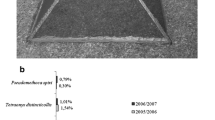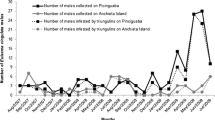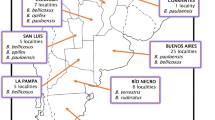Abstract
Natural enemies are one of the main mortality factors in bees and wasps attacking either immature stages or adults of their hosts. Dipterans of the genus Physocephala (Diptera: Conopidae) are parasitoids that attack adult bees during their field activities, and the parasitoid larvae develop inside the host abdomen. However, little is known about the biology of these natural enemies and their interactions with their solitary bee hosts. This study is aimed at analyzing attacks by conopid flies in one of their hosts, the solitary bee species Centris analis (Apidae: Centridini), and the consequences in the nesting behavior of this bee species. Higher incidences of parasitism occurred during the hot/wet season, and seven fly species attacking C. analis were identified. Of the fifty-six females observed during their nesting activities, seven of them were parasitized. These females showed alterations in their nesting behavior, depositing extra oil on the plug of finished nests and building plugs in empty cavities. The behavioral changes observed in these females began during larval stage L1 of the parasitoid. In the last stages of parasitoid development (L3 PUP and pupa), the bees ceased their flight activities and entered cavities at the nesting site, remaining there until death.



Similar content being viewed by others
References
Abdalla FC, Sampaio G, Pedrosa M, Sipriano TP, Domingues CEC, Silva-Zacarin EC, Camargo DA (2014) Larval development of Physocephala (Diptera, Conopidae) in the bumble bee Bombus morio (Hymenoptera, Apidae). Rev Bras Entomol 58:343–348
Alcock J (1980) Natural selection and the mating systems of solitary bees. Am Sci 68:146–153
Alford DV (1975) Bumblebees. Davis-Poynter, London
Alonso JDS, Silva JF, Garófalo CA (2012) The effects of cavity length on nest size, sex ratio and mortality of Centris (Heterocentris) analis (Hymenoptera, Apidae, Centridini). Apidologie (Celle) 43:436–448
Camillo E, Garófalo CA, Serrano JC, Muccillo G (1995) Diversidade e abundância sazonal de abelhas e vespas solitárias em ninhos armadilhas (Hymenoptera, Apocrita, Aculeata). Rev Bras Entomol 39:459–470
Camras S (1957) A review of the New World Physocephala (Diptera: Conopidae). Ann Entomol Soc Am 50:213–218
CIIAGRO (2017) Centro Integrado de Informações Agrometeorológicas. Governo do Estado de São Paulo. http://www.ciiagro.sp.gov.br/. Accessed 20 March 2017
Couto RM, Camillo E (2014) Deposições de óleo por fêmeas de Centris analis (Fabricius) (Hymenoptera: Apidae: Centridini) parasitadas por Physocephala spp. (Diptera: Conopidae). EntomoBrasilis 7:81–85
Cremer S, Armitage SAO, Schmid-Hempel P (2007) Social immunity. Curr Biol 17:693–702
Davis E, Malfi R, Roulston TH (2015) Species differences in bumblebee immune response predict developmental success of a parasitoid fly. Oecologia 178:1017–1032. https://doi.org/10.1007/s00442-015-3292-8
Gazola AL, Garófalo CA (2003) Parasitic behavior of Leucospis cayennensis Westwood (Hymenoptera: Leucospidae) and rates of parasitism in populations of Centris (Heterocentris) analis (Fabricius) (Hymenoptera: Apidae: Centridini). J Kansas Entomol Soc 76:131–142
Gibson JF, Slatosky AD, Malfi RL, Roulston T, Davis SE (2014) Eclosion of Physocephala tibialis (say) (Diptera: Conopidae) from a Bombus (Apidae: Hymenoptera) host: a video record. J Entomol Soc Ont 145:51–60
Goulson D (2010) Bumblebees; their behaviour, ecology and conservation. Oxford University Press, Oxford
Hines HM, Cameron SA, Deans AR (2007) Nest architecture and foraging behavior in Bombus pullatus (Hymenoptera: Apidae), with comparisons to other tropical bumble bees. J Kansas Entomol Soc 80:1–15
Hurd PD (1978) Na annotated catalog of the carpenter bees (genus Xylocopa Latreille) of the Western Hemisphere. Smithsonian Institution Press, Washington
Köppen W (1948) Climatologia: con un estúdio de los climas de la Tierra. Fondo de Cultura Económica, Mexico
Libersat F, Delago A, Gal R (2009) Manipulation of host behavior by parasitic insects and insect parasites. Annu Rev Entomol 54:189–207
Linsley EG (1958) The ecology of solitary bees. Hilgardia 27:543–599
Lucia M, Gonzalez VH, Abrahamovich AH (2010) Systematics and biology of Xylocopa subgenus Schonnherria (Hymenoptera, Apidae) in Argentina. Zookeys 543:129–167
MacFarlane RP, Lipa JJ, Liu HJ (1995) Bumble bee pathogens and internal enemies. Bee World 76:130–148
Malfi RL, Roulston TH (2014) Patterns of parasite infection in bumble bees (Bombus spp.) of Northern Virginia. Ecol Entomol 39:17–29
Malfi RL, Davis SE, Roulston TH (2014) Parasitoid fly induces manipulative grave-digging behavior differentially across its bumblebee hosts. Anim Behav 92:213–202
Melo GAR, Faria LRR Jr, Marchi P, Carvalho CJB (2008) Small orchid bees are not safe: parasitism of two species of Euglossa (Hymenoptera: Apidae: Euglossina) by conopid flies (Diptera: Conopidae). Rev Bras Zool 25:573–575
Mesquita TMS, Augusto SC (2011) Diversity of trap-nesting bees and their natural enemies in the Brazilian savanna. Tropical Zoology 24:127–144
Milinski M, Parker GA (1991) Competition for resources. In: Krebs JR, Davies NB (eds) Behavioral ecology: an evolutionary approach, 3rd edn. Blackwell Scientific, Oxford, pp 137–168
Moure JS (1960) Notes on the types of the Neotropical bees described by Fabricius (Hymenoptera: Apoidea). Stud Entomol 3:97–160
Moure-Oliveira D, Rocha Filho LC, Ferreira-Caliman MJ, Garófalo CA (2017) Nesting dynamic and sex allocation of the oil-collecting bee Centris (Heterocentris) analis (Fabricius, 1804) (Apidae: Centridini). J Nat Hist 51:1151–1168
Müller CB (1994) Parasitoid induced digging behaviour in bumblebees workers. Anim Behav 48:961–966
Müller CB, Schmid-Hempel R (1992) To die for host parasite? Anim Behav 44:177–179
Otterstatter MC (2004) Patterns of parasitism among conopid flies parasitizing bumblebees. Entomol Exp Appl 111:133–139
Pais MP, Varanda EM (2010) Arthropod recolonization in the restoration of a semideciduous forest in southeastern Brazil. Neotrop Entomol 39:198–206
Park T (1954) Experimental studies of interspecies competition. II. Temperature, humidity, and competition of two species of Tribolium. Physiol Zool 27:177–238
Plischuk S, Salvarrey S, Arbulo N, Santos E, Skevington JH, Kelso S, Revainera PD, Maggi MD, Invernizzi C, Lange CE (2017) Pathogens, parasites, and parasitoids associated with bumble bees (Bombus spp.) from Uruguay. Apidologie (Celle) 48:298–310
Polidori C, Scanni B, Scamoni E, Giovanetti M, Andrietti F, Paxton RJ (2005) Satellite flies (Leucophora personata, Diptera: Anthomyiidae) and other dipteran parasites of the communal bee Andrena agilissima (Hymenoptera: Andrenidae) on the island of Elba, Italy. J Nat Hist 39:2745–2758
Pouvreau A (1974) Les enemies des bourdons. II. Organismes affectant les adultes. Apidologie (Celle) 5:39–62
R Core Team (2018) R: A language and environment for statistical computing. Version 3.5.0. R Foundation for Statistical Computing, Vienna, Austria. Available from https://www.R-project.org/
Rasmussen C, Cameron SA (2004) Conopid fly (Diptera: Conopidae) attacking large orchid bees (Hymenoptera: Apidae: Eulaema). J Kansas Entomol Soc 77:61–62
Rocha-Filho LC, Silva CI, Gaglianone MC, Augusto SC (2008) Nesting behavior and natural enemies of Epicharis (Epicharis) bicolor Smith 1854 (Hymenoptera Apidae). Tropical Zoology 21:227–242
Roubik DW (1989) Ecology and natural history of tropical bees. Cambridge University Press, New York
Roulston TH, Goodell K (2011) The role of resources and risks in regulating wild bee populations. Annu Rev Entomol 56:293–312
Rozen JG Jr (1991) Evolution of cleptoparasitism in anthophorid bees as revealed by their mode of parasitism and first instars (Hymenoptera: Apoidea). Am Mus Novit 3029:1–36
Santos AM, Serrano JC, Couto RM, Rocha LSG, Mellopatiu CA, Garófalo CA (2008) Conopid flies (Diptera: Conopidae) parasitizing Centris (Heterocentris) analis (Fabricius) (Hymenoptera: Apidae, Centridini). Neotrop Entomol 37:606–608
Schmid-Hempel P (2001) On the evolutionary ecology of host–parasite interactions: addressing the question with regard to bumblebees and their parasites. Naturwissenschaften 88:147–158
Schmid-Hempel P, Durrer S (1991) Parasites, floral resources and reproduction in natural populations of bumblebees. Oikos 62:342–350
Schmid-Hempel P, Schmid-Hempel R (1990) Endoparasitic larvae of conopid flies alter pollination behavior of bumblebees. Naturwissenschaften 77:450–452
Schmid-Hempel R, Schmid-Hempel P (1991) Endoparasitic flies, pollen-collection by bumblebees and a potential host-parasite conflict. Oecologia 87:227–232
Schmid-Hempel R, Schmid-Hempel P (1996) Larval development of two parasitic flies (Conopidae) in the common host Bombus pascuorum. Ecol Entomol 21:63–70
Schmid-Hempel P, Müller C, Schmid-Hempel R, Shykoff JA (1990) Frequency and ecological correlates of parasitism by conopid flies (Conopidae, Diptera) in populations of bumblebees. Insect Soc 37:14–30
Silva CI, Hirotsu CM, Pacheco Filho AJS, Queiroz EP, Garófalo CA (2017) Is the maximum reproductive rate of Centris analis (Hymenoptera, Apidae, Centridini) associated with floral resource availability? Arthropod Plant Interact 11:389–402
Smith KGV, Peterson BV (1987) Conopidae. In: McAlpine JF, Peterson BV, Shewell GE, Teskey HJ, Vockeroth JR, Wood DM eds. Manual of Nearctic Diptera. Ottawa, Research Branch Agriculture Canada
Stuke JH (2017) World catalogue of insects. Conopidae (Diptera). Leiden, Boston, E.J. Brill
Stuke JH, Cardoso CF (2013) Physocephala inhabilis (Walker) (Diptera: Conopidae) parasitizing Megachile (Moureapis) maculata Smith (Hymenoptera: Megachilidae). Stud Dipterol 20:39–43
Stuke JH, Lucia M, Abrahamovich AH (2011) Host records of Physocephala wulpi Camras, with a description of the puparium (Diptera: Conopidae). Zootaxa 3038:61–67
Vieira de Jesus BM, Garófalo CA (2000) Nesting behaviour of Centris (Heterocentris) analis (Fabricius) in southeastern Brazil (Hymenoptera, Apidae, Centridini). Apidologie (Celle) 31:503–515
Wcislo WT, Cane JH (1996) Floral resource utilization by solitary bees (Hymenoptera: Apoidea) and exploitation of their stored foods by natural enemies. Annu Rev Entomol 41:257–286
Acknowledgments
The authors thank the Center of Research in Biodiversity and Computation (BioComp) for the technical support. We are also grateful to Fábio C. Abdalla for the help with the identification of the parasitoid larval stages, to Dalton de Souza Amorim and Vera Cristina Silva for their help solving taxonomic problems related with Physocephala soror and Physocephala inhabilis, and Léo C. Rocha-Filho for his comments that improved the text. We want to thank three anonymous reviewers for making relevant suggestions, which have refined the manuscript.
Funding
DMO and CMH are thankful to Conselho Nacional de Desenvolvimento Científico (CNPq) for fellowships (grant numbers 140159/2014-2 and 134873/2010-6, respectively). CAG received a research scholarship (process number 310679/2014-1) from CNPq.
Author information
Authors and Affiliations
Corresponding author
Ethics declarations
Conflict of interest
The authors declare that they have no conflict of interest.
Additional information
Communicated by: Matthias Waltert
Publisher’s note
Springer Nature remains neutral with regard to jurisdictional claims in published maps and institutional affiliations.
Rights and permissions
About this article
Cite this article
Moure-Oliveira, D., Hirotsu, C.M., Serrano, J.C. et al. Host-parasitoid interactions between the solitary bee Centris analis (Apidae: Centridini) and conopid flies (Diptera: Conopidae). Sci Nat 106, 39 (2019). https://doi.org/10.1007/s00114-019-1634-9
Received:
Revised:
Accepted:
Published:
DOI: https://doi.org/10.1007/s00114-019-1634-9




